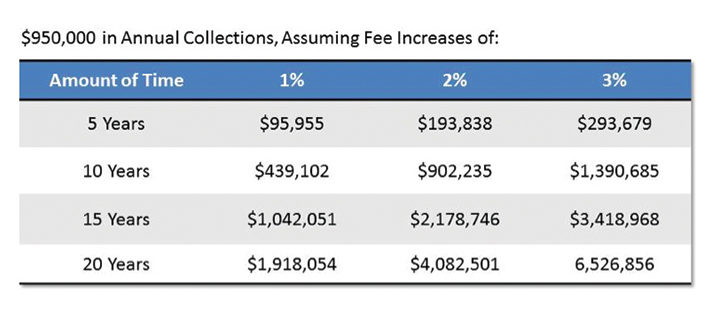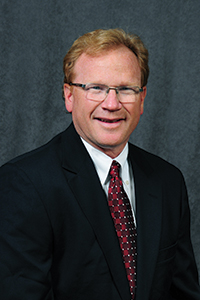Chris Bentson offers tips for growing a practice in a competitive economy
 As valuation and transition consultants, we have the duty to analyze a practice for sale or purchase with great scrutiny. When performing a practice valuation study, we analyze the last 3 years of a practice’s financial performance and operational performance for each practice. This provides us not only the revenue and expenses, but the patient flow, the conversion ratios from new patient exams to starts, the fee structure, the marketing plan, etc. More importantly, when visiting each practice, we observe the physical facility, fixed assets in service, staff, location within the practice’s drawing area, competitors’ location(s), and so on. We also perform a detailed demographic analysis of the patient drawing area. Needless to say, we end up with a great deal of data on each practice; and have the opportunity to see practices in every geographic region of the country.
As valuation and transition consultants, we have the duty to analyze a practice for sale or purchase with great scrutiny. When performing a practice valuation study, we analyze the last 3 years of a practice’s financial performance and operational performance for each practice. This provides us not only the revenue and expenses, but the patient flow, the conversion ratios from new patient exams to starts, the fee structure, the marketing plan, etc. More importantly, when visiting each practice, we observe the physical facility, fixed assets in service, staff, location within the practice’s drawing area, competitors’ location(s), and so on. We also perform a detailed demographic analysis of the patient drawing area. Needless to say, we end up with a great deal of data on each practice; and have the opportunity to see practices in every geographic region of the country.
Taken together, we see practices that are declining at various rates, practices that are maintaining a relatively flat “status quo” with regards to growth, and practices that are growing at various rates. We see these practices in all areas of the country, in all environments, generally battling a similar competitive and economic environment. We would like to provide a partial summary of common threads we have observed in practices that are growing versus ones that are not over the last several years. We hope to offer some ideas, habits, and choices that doctors/owners have made to grow a practice in a very slow-growing economy, with increasing scrutiny by consumers who are largely feeling an economic pinch. Parents are looking to save money where they can, including the investment in orthodontic care for themselves or more to the point, their children.
Before discussing the elements of growth, below are a few necessary comments regarding general practice growth.
- Not all practices can grow. There are many contributing reasons as to why a practice cannot grow: competitive environment, demographic environment, geographic limitations, and so on; however, our observation of the number one reason practices cannot grow is because they do not currently operate with efficient systems. Systems, as we will discuss later in this article, are perhaps the key foundation to growth and without them, a practice in chaos will experience greater chaos as it makes decisions and tries to grow, ultimately imploding under the weight of poor systems. Some examples can be the following:
- If patients are not seated on time, adding growth to a practice will only exacerbate the problem.
- If cases are not finishing on time, growth presents real problems as chairs fill up with unhappy zero contract balance patients.
- If the highest level of customer service cannot be currently offered, then providing the same average, predictable, run-of-the-mill, mediocre service inhibits growth.
- If the staff is turning over at an accelerated rate, and there is gossip, backstabbing, and an ununified team that is just getting by, growth is not in a practice’s future.
- If there is poor direction and leadership from the owner, counting on the staff to pick up the leadership role and grow the practice is likely not going to occur.
- Not all practices should grow, even if they can. What? We have seen many practice owners who are professionally and financially satisfied with the practice just the way it is. These owners are wired a certain way and like a predetermined pace and flow. Growing their practice would invite things into their lives they don’t want — more time at the practice, more problems, more staff, more of this or that. Growth for these owners can come with a price they do not want to pay or they are not well suited for. As one doctor put it to me years ago, “I take a set off every day, I put a set on every day; that is just the way I like it and have been doing it for 20 years.” Only grow if one desires to deal with what comes with growth.
- Growth is a choice. Unlike certain time periods in the last 20 years when we observed practices growing just because they existed year after year, today practice owners must choose to grow. Growth is intentional. It is planned for. It is measured and monitored. It requires investment and risk of capital and time. It requires leadership.
What have we perceived in practices that are growing, and what observations do we have regarding growth? We are seeing multiple strategies and paths to achieve growth. There is no silver bullet, no one, sure fire, can’t miss strategy. While we could discuss dozens of ideas, we will center on seven areas for practice owners to consider as they develop a growth strategy for their practice. These areas are:
- Fee analysis
- Increasing referrals
- Starting more patients
- Finding more patients
- Product mix
- Buying a competitor
- Opening a satellite
Fee analysis:
Regardless of the price being charged, fees should be examined in three areas.
- Am I collecting what I’m charging?
- Am I raising my fees annually?
- Am I flexible with my fees?
One of the easiest ways to grow the top and bottom line is to collect the highest percent possible of the fees charged. Insurance can be a bit of a wild card and requires a higher level of expertise, but with current practice management software, this can be handled efficiently and correctly. However, one of the biggest changes in collection procedures in the last decade has been automatic payment. Roll back the orthodontic tape to the early 1980s, and most practices were seeing patients on a 4-to-6 week interval and giving hand-punched coupon books to patients for payment reminders. Patients often associated payment with visit. Fast forward to the 1990s, and by the end of the decade, we went from the handwritten ledger card bin to almost 90% of practices being computerized, meaning daily aging reports were easy to obtain, monthly statements were printed or sent electronically to patients, and a raft of collection reports were available as tools to assist financial coordinators in collection of fees due. Over the past 10 years, most practices are now using automatic payment draft of the monthly payment. Companies such as OrthoBanc and Vanco services are being used. Local banks can provide this service in most communities, and many practice management systems have not only the functionality to auto draft payments but also an interface via the web for patients to make payments. Our observation is that growing practices exhibit extraordinarily high levels of collections and low delinquency rates in part by invoking technology to auto draft a monthly payment, giving financial coordinators time to work the tough ones and deal with the insurance companies.
 A suggestion made by many practice management consultants is to raise practice fees each year. This is one of the best ways to hedge profits against increasing overhead. While we have been living in an environment of almost unprecedented low interest rates and inflation rates, there is a common belief among economists that these low levels are not permanent, and some increases in these areas will occur. When and if they do, practice owners that are not annually increasing fees will feel a lighter weight in their wallets and find it difficult to catch up in one big move. In fact, practice owners leveraged on fixed fee insurance plans may find it against policy to make an upward price in their services above a certain threshold annually. A best practice is to monitor the economy and make fee increases annually that are near or just below the economic growth rate (for the last several years this has been anemic and under 3%). The chart on the previous page shows the effect of small fee increases over a career. The chart assumes annual collections of $950K per year (the mean collection rate as reported in The Journal of Clinical Orthodontics (JCO) Orthodontic Practice Study), assumes no growth over 20 years for the practice and shows the affect of a 1%, 2%, or 3% price increase to a practice owner at 5-year intervals for 20 years.
A suggestion made by many practice management consultants is to raise practice fees each year. This is one of the best ways to hedge profits against increasing overhead. While we have been living in an environment of almost unprecedented low interest rates and inflation rates, there is a common belief among economists that these low levels are not permanent, and some increases in these areas will occur. When and if they do, practice owners that are not annually increasing fees will feel a lighter weight in their wallets and find it difficult to catch up in one big move. In fact, practice owners leveraged on fixed fee insurance plans may find it against policy to make an upward price in their services above a certain threshold annually. A best practice is to monitor the economy and make fee increases annually that are near or just below the economic growth rate (for the last several years this has been anemic and under 3%). The chart on the previous page shows the effect of small fee increases over a career. The chart assumes annual collections of $950K per year (the mean collection rate as reported in The Journal of Clinical Orthodontics (JCO) Orthodontic Practice Study), assumes no growth over 20 years for the practice and shows the affect of a 1%, 2%, or 3% price increase to a practice owner at 5-year intervals for 20 years.
Flexibility with fees is perhaps the greatest tool implemented by growing practices. Growing practices have a system in place to access risk and make it easy for the consumer to do business. A practice that is married to “x”% down and the balance ratably paid over “x” number of months needs to realize other options in the market are available to consumers. While the level of risk and how much flexibility should be granted can be debated, a prudent approach of appropriate credit risk analysis, coupled with excellent communication and collections systems, can allow many practices to allow more flexible options and still have a high probability of collecting fees. Consumers do not and should no longer associate visit with payment, and as this relationship is uncoupled in a practice, and more flexible payment options are afforded, it is likely for the practice to get to “yes” more frequently in the new patient process.
Increasing referrals:
Gaining, asking for, and in some cases, rewarding a general dentist or pediatric dentist for professional referrals of patients is a time-honored tradition within the orthodontic profession. Yet over the past several years, orthodontists have seen fewer referrals from this group than ever before. The JCO’s Orthodontic Practice Study, published biannually, shows a decrease of almost 10% over the last 8 years. Still necessary and viable, growing practices have a two-pronged approach to their communication with referring practices:
- Doctor-to-doctor
- Practice-to-staff
Doctor-to-doctor communication is, and always will be, an important marketing element of most orthodontic practices. While the golf outings, sporting event tickets, and holiday gifts can still be a component, the following approach helps the doctor-to-doctor relationship turn into more patient referrals:
- Ask how? Most orthodontic practices communicate with all referrals in the same manner. Each referral receives the same letter, the same form, the same everything. We have seen doctors, especially new and younger, asking referring general practitioners how they want to be communicated with (electronic or paper). They also inquire what information they want to receive, demonstrating the ability to deliver specifically what the referral wants, ultimately leading the relationship ahead. This level of customization requires asking first versus telling, listening well, and then having the ability to execute and “customize” how to communicate to each referring general practitioner or pediatric dentist.
- Focus on education. Focusing communication with referring doctors on educational matters is often viewed as superior to “gifting.” Most small business owners and dentists share some common problems, such as: meeting CE requirements, human resource issues, handling dismissing patients, or dealing with multidisciplinary cases. Offering opportunities to educate, whether on orthodontic modalities or small business issues, are valuable to both parties and helpful in strengthening a referring doctor relationship.
- Be an escape valve. If a referring doctor is providing orthodontic services, it can be a great relationship builder to get him/her out of a problem case he/she should not have accepted in the first place. It does not always come full circle, but there are a great many orthodontists who can testify to an increase in referrals after bailing out a poorly progressing case from another dentist.
Perhaps just as important to the doctor-to-doctor relationship is the relationship a practice develops with the referring doctors’ staff. This goes beyond donut and bagel runs.
- Know them. Start with first and last names, positions, children, birthdays, and staff anniversary dates. Have staff assigned to knowing the front desk and the hygienists in the general dental offices. Recognize significant events. Just like the television show Cheers theme song, you want to be “where everybody knows your name.”
- Include them. Visiting the referring doctors’ offices is not just to provide a nice holiday gift to the doctor, but provide something to the staff. A growing practice has a calendar with visit dates outlined over the full course of the year. Whether it is lunch, lip gloss, gift cards, game tickets, or invitations to events for the community the practice is sponsoring, be sure to include the referring doctors’ staff.
- Treatment. This one is all over the map, and there are many opinions. Decide if any treatment discounts or options will be available for referring staff, their spouse, or children. It is difficult to pass out three referring orthodontic cards at the front desk and successfully dodge the “Who’s your orthodontist?” question if the front desk person is an active orthodontic patient in your practice.
Stay Relevant With Orthodontic Practice US
Join our email list for CE courses and webinars, articles and mores

 Chris Bentson, president, Bentson Clark & Copple, LLC of Greensboro, North Carolina, has been working with orthodontists regarding the business aspects of their practices for more than 23 years. He also serves as editor-in-chief of the Bentson Clark reSource, a quarterly newsletter focused on the business aspects of running a successful orthodontic practice. He is a frequent guest lecturer and has personally visited over 1,000 orthodontic practices in the United States, Canada, and Australia. He can be reached at 1-800-621-4664 or via email at
Chris Bentson, president, Bentson Clark & Copple, LLC of Greensboro, North Carolina, has been working with orthodontists regarding the business aspects of their practices for more than 23 years. He also serves as editor-in-chief of the Bentson Clark reSource, a quarterly newsletter focused on the business aspects of running a successful orthodontic practice. He is a frequent guest lecturer and has personally visited over 1,000 orthodontic practices in the United States, Canada, and Australia. He can be reached at 1-800-621-4664 or via email at 
